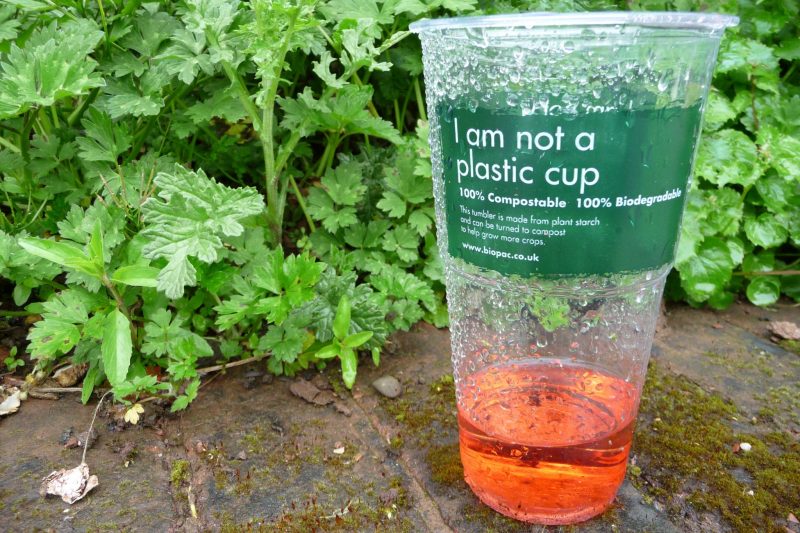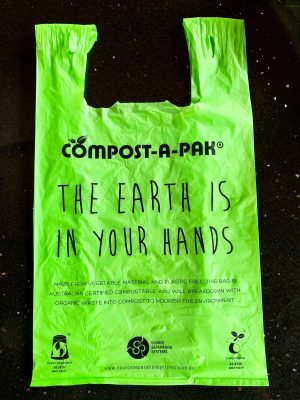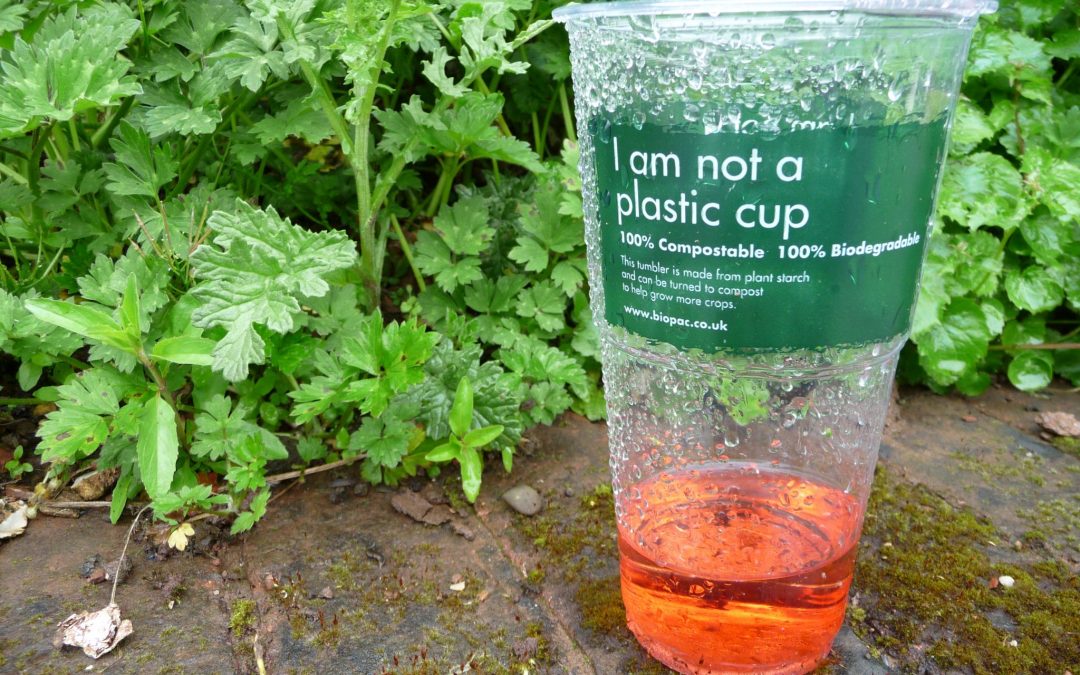Plastic pollution has recently been emerging as one of the world’s most pressing environmental issues, with poor and racialized communities around the world disproportionately affected by the entire lifecycle of oil extraction, plastic production, unsafe recycling, polluted beaches, and plastic landfilling. In light of this, industry has been working hard to produce alternatives to traditional plastics, especially for single use items. Often, this looks like compostable products, which individuals and businesses pay a premium for because they care about the environment. Compostable plastics aren’t a straightforward “win” for the environment, unfortunately. Here we unpack and demystify the terms, what compostable plastics really are, and what the end of their life looks like. Skip to the end if you just need the action steps!
Demystifying the Terms
Whether on store shelves or on your takeout containers, you may have seen products making claims like “biodegradable packaging” or “this plastic is made from plants”. Other claims out there include “oxodegradable”, “compostable”, “fully compostable”, “biobased plastic”, and “bio-PET”. We’ve seen these on everything from straws, cups, plates, and utensils, to garbage bags, general packaging, and coffee pods. These terms all sound pretty green to the consumer, but what you might not know is that they all mean different things! Read on to avoid getting greenwashed.
Oxodegradable, Biodegradable, etc
Oxodegradable is another word for biodegradable, under conditions where oxygen is present. These plastics may be bio-based, or they may be made from fossil fuels, but they generally contain an additive which helps them break down faster. Exactly what happens when it is broken down is somewhat controversial, but they likely produce microplastics. They also need specific conditions to break down, which are not usually present in landfills.
Biobased plastic is generally chemically identical to fossil-fuel based plastic, but it uses molecules derived from plants, food waste, or lobster shells instead. According to CBC “The only difference between biopolyethylene or bio-PET (used in Coke’s “PlantBottle”) and regular polyethylene or PET is they use a raw ingredient from plants (ethanol) instead of fossil fuels to make the same material…Because they’re identical, they take just as long as traditional plastics to break down”.
This is a good step forward because it uses renewable resources and has a smaller carbon footprint over its lifespan, but it doesn’t solve the waste and recycling problems at all. Even worse? A product can be labelled a bioplastic and still be mostly made from fossil fuels! Labelling requirements are not very strict and only require a small percentage of the product to be made from bioplastic to use the term. It’s even possible to have a 100% fossil-fuel created plastic labelled a bioplastic, if it is biodegradable – see the problems with “biodegradable” above.
We say: nice try, but no cigar. This is greenwashing.
Biodegradable
Biodegradable sounds great, but doesn’t mean a whole lot. There is no standard for what this term actually means, so just like products branded “natural”, don’t be pulled in by the term. Biodegradable plastic, whether “bio-based” or otherwise, has a chemical additive that helps to speed up breakdown. By “speed up”, we mean timespans of about a decade, as opposed to dozens or even hundreds of years. Biodegradable plastics are likely to break down into smaller and smaller pieces of plastic, eventually creating those microbeads we all want to avoid – and if they’re buried in a landfill far from light, oxygen, and water, they may not even do that. In the end, they’re still plastic.

Compostable Plastics
In general, an item is compostable if two conditions are met: 1) it is made up entirely of “organic” elements (derived from living organisms) and 2) it will decompose into an organic compound called compost. This compost is used as a soil amendment to improve the soil texture and add nutrients that are beneficial to plants. It can even help soils to act as a more efficient carbon “sink” to remove carbon dioxide from the atmosphere!
According to the Biodegradable Products Institute (BPI), in order for a package to be considered compostable, it must break down within a specific timeframe. Most facilities need materials to break down in 80 days or less. This material must biodegrade at a rate comparable to yard trimmings and food scraps, and they must disintegrate so that no large plastic fragments remain to be screened out. Compostable plastics are made from plants, not fossil fuels, and they should be certified compostable by an organization like BPI. Because they don’t contribute to more unsustainable extraction of non-renewable fossil fuels, and because they can break down in the proper composting facilities, this claim isn’t usually greenwashing. However, there are still issues with compostable plastics. To understand these, first we need to understand the types of compostable plastics.
Types of Compostable Plastics
Polylactic Acid, or PLA, is one of the most common compostable plastics used today. Under the right conditions, it breaks down to carbon dioxide, water, and compost, and does not produce microplastics. Products often made with PLA include clear disposable drinking cups, clamshell containers, compost bags or compostable garbage bags, and plastic cutlery. In theory, you can recycle PLA, but almost no recycling programs accept it. The market to buy it and the facilities to recycle it don’t currently exist.
Two other types of compostable plastic that make up significant portions of the world market are Ecoflex, and various starch based blends. Ecoflex is a biodegradable polyester that is certified compostable and made by the company BASF. Starch blends might be familiar to you in the form of grocery bags stating that they are made from cornstarch, though they’re used in many other products as well.
 Problems with Compostable Plastics
Problems with Compostable Plastics
1. Compostable products are not designed for home composting systems
Compostable products are tested for use in large-scale, commercial composting systems. These get much hotter, and are more carefully managed, than a typical backyard compost heap. For a compostable plastic to actually compost, it needs high heat and large amounts of oxygen, or it won’t break down.
2. Lack of infrastructure: No access to composting
Many municipalities, especially smaller ones, do not have easy access to commercial composting that can handle compostable plastics. This means that that compostable dog-poo bag you paid extra for? It’s still going in the landfill, where it will slowly break down, producing methane gas (a greenhouse gas 25x more potent than carbon dioxide) in the process. In Winnipeg, Brady Landfill is Manitoba’s second-largest point-source greenhouse gas emitter, largely due to organics (including compostable plastics).
3. Lack of infrastructure: Composting systems can’t handle compostable plastics
Many places that do have commercial composting facilities still struggle to accept compostable plastics. There’s a number of reasons for this, depending on the facility, but they include:
-
- Compostable plastics can look the same as non-compostable plastics, making it difficult to sort out what is a contaminant, and leading to contamination of the finished compost with plastics
- Open composting facilities may find compostable bags blow away, rather than composting
- Facilities designed to deal with leaf and yard waste exclusively are not set up for compostable plastics
- Composting facilities have a careful “recipe” to produce finished compost, and different feedstocks coming in unexpected quantities and ratios can make this challenging. Current “recipes” need to be redesigned to handle compostable plastics
- Compostable plastics vary dramatically: a filmy plastic bag and a chunky plastic fork compost at very different rates, for example. Compostable cutlery and clamshells may need to be pre-shredded before being added to a compost pile.
- Compostable plastics may affect certification (and therefore saleability and value) of finished compost, depending on local regulations
Just like recycling, just because something can be composted, doesn’t mean it is composted.
The Recycling Council of Ontario’s Plastic Action Centre has a great infographic about bioplastics if you’re a visual learner.
Now What?
As an individual citizen, the challenges of how to make the best, lowest-waste, lowest-impact choices can be overwhelming. There is usually no straightforward right answer – and that’s the case with compostable plastics. That said, here are a few rules of thumb you can use going forward, and some actions you can take to make a difference for good!
1. When in doubt, first “refuse” and “reduce”. Do you need a compost bag, or can you just rinse your bucket after dumping it in your backyard bin? Can you use a pooper scooper to grab dog poo and put it in a pet waste digester, instead of grabbing it with a plastic (or compostable plastic) baggie?
2. If you can’t reduce, try to reuse – or choose a reusable option. Eating takeout? A metal fork from the thrift store that you keep wrapped in a napkin in your purse or backpack has a much lower impact than a compostable fork.
3. Stuck with a single-use item? Here’s a few questions you can ask yourself to figure out your personal best option:
-
- What will happen to this when I’m done with it? (If it’s compostable, are there compost facilities available? If it’s recyclable, is it accepted in the local system? Will you be willing to take it with you to properly dispose of it if there are no waste sorting bins close at hand?)
- If it’s going to be thrown out either way, what is it made out of? (Is it made from a renewable resource? Compostable plastics often are. This is a step up from a conventional plastic that is typically made from a nonrenewable resource)
- What option has the least amount of waste associated with it? (A fast food wrap in a single sheet of paper has a lot less waste than a fast food salad in a clamshell bowl of black, non-recyclable plastic
- Who can I constructively express my frustration to?
Ok, technically this won’t help you make a better choice in the moment, but citizen voices help change governmental regulations, and customer voices help shift business practices. Can you fill out a comment card? Mention something to a manager? Write a letter to a business? Meet with your government representative? Sign a petition? Attend a protest? Write a letter to the editor? Boycott particularly problematic examples of waste? Find the method of agitating for change that suits you best, and give it a go!




Thank you for this informative article. What I find highly ironic is that many restaurants, in their attempt to be more compliant or sustainable are using these PLA based containers for take out. But now the consumer is actually in a worse position because we can’t do anything with these containers! At least styro and plastic can be repurposed through recycling (though I would rather not have to do that!). I just can’t see Canadian cities changing the compost recipe for this type of packaging.
May is migration season for the birds and waterfowl.
Omand’s Creek area is choked with plastic in the water and creek banks. Plus all other sorts of litter and debris.
All of this is very harmful to the birds and waterfowl plus the water and land.
It also looks very bad, discouraging to say the least!
I encourage and challenge everyone to pick up any debris at anytime in the Omand’s Creek area from Portage Ave down Empress Street to Notre Dame Ave. I use my garden gloves and bags to do this.
Please help as soon as you can, greatly appreciated!!
You’re right Leesa!
We will be having an Omand’s Creek cleanup event later in the summer, for those who would like to participate with more of a group doing this work. Unfortunately it has had to be postponed from the original date of May 29th due to gathering restrictions, but watch this Event space for updates: https://greenactioncentre.ca/event/omands-creek-cleanup-3/
Hi Teresa,
it is a really interesting topic you discussed here in your article. Lack of infrastructure is a really big problem for Canada. Without solving that problem it would be hard to solve the plastic problem. Just imagine even if the plastic ban is implemented in Canada and certified compostable products are exempt from this ban, still many municipalities cannot process the compostable products without proper facilities. So, this upcoming plastic ban is a half measure but a step in the right direction..
Our company – https://compostable-bags.ca/ sells certified home compostable shopping bags. It is Home OK compost certification you mentioned in your comment. We will be glad to send you samples of our bags so you can run your test on them. Please let me know if you are interested. I will be eager to see the results of such a test. Thank you.
This is great. Thank you for the article. Although, one observation: in the market it is already possible to buy home compostable bags. So written problems does’t apply to those bags. Not sure what are down sides of those bags, but it would be good to talk about them too.
Hi Airida,
You’re right that it is possible to find home compostable bags, though almost none that I’ve seen personally have been certified for home compost. The BPI certification is only for industrial compost facilities. It’s still a rare thing to see them; they’re so new that since this blog article was originally written (in about 2018), the market has already started to shift! I haven’t personally tested the “home compostable” products, so I can’t vouch for the conditions that they need, but here’s a link to more info on the main home compostability certification I’ve been seeing in Manitoba lately: https://www.tuv-at.be/green-marks/certifications/ok-compost-seedling/.
Home compostability for compostable and biodegradable plastics is not widely regulated, so at minimum I would look for a certification like the one I shared above. The main product I’ve been seeing lately claiming home compostability is shipping envelopes – I intend to run a home test on one of them soon, and I hope it holds up to the claims! The problem is that home composts vary dramatically, from a high heat very active bin, to a very slow, cold compost that may take years to fully decompose. Compostable plastics that say “home compostable” may be suitable for some, but not all, home composts, so basically I’m saying here: your mileage may vary.
The only other downside to point out is that it’s always better to choose reusable vs. disposable, when you have the option.
Once we have a bit more info on home compostable plastics, we’ll be sure to add it to the post!
Thanks for your input, and happy composting.
“A metal fork from the thrift store that you keep wrapped in a napkin in your purse or backpack has a much lower impact than a compostable fork.”
Thank you so much for saying this rather than suggesting people buy a new fancy bamboo set of cutlery for their bag.
We definitely agree with you that we should use what we have first! Bamboo utensils can be a great option for some (especially if you’re taking them through a metal-detector!), but thrift store utensils are lower-waste and more cost-accessible.